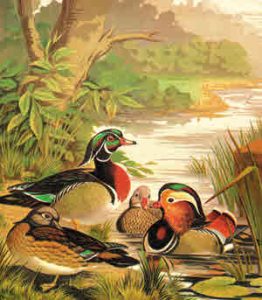 Feeding Regimen & Home Made Duck Feed by Katie Thear
Feeding Regimen & Home Made Duck Feed by Katie Thear
Our practice, which always worked well, was to give a compound ration of pellets in the morning, when the ducks were first let out of their house.
The pellets were placed in a long, wide and heavy based feeder that they could not tip over.
Ducks’ bills are adapted for scooping so that the bill goes into and under the food. It is important to avoid powdery foods otherwise the nostrils can become clogged.
If a compound mash (powder) ration is given rather than a pelleted feed, it should be moistened with water in order to produce a crumb consistency. This can also clog the nostrils however, and I prefer to give pellets so that this problem does not occur.
The feeder also stays cleaner, an important aspect in preventing disease. All feeders should, of course, be cleaned on a regular basis.
Whatever form the food is in, there should be fresh water nearby. Domestic ducks will often eat some food, then waddle over to the drinker before returning for some more food. Having the feeder and drinker close to each other therefore makes sense.
In a run, it is a good idea to have these placed on a slatted area so that water falls through, otherwise there will soon be a marsh.
As soon as our ducks had eaten, they would rush off to the pond, spending the rest of the day dabbling about there, and browsing on the grass and in the hedges. In the afternoon, they were given their grain ration on the grass.
More pond dabbling and browsing would ensue until dusk when they went into their house for the night. If ducks are reluctant to go in, a little bit of grain in the house soon makes them change their minds. Once they are going in, however, it is as well to discontinue the practice, in case rats are attracted to the house and gnaw their way in.
Home feeds
Home-produced feed can be given, as long as it does not provide too much of one thing at the expense of other nutrients.
Suitable ingredients include green or vegetable garden foods such as nettles, lettuce, carrots, brassicas and alfalfa (lucerne), etc. They should be well chopped or shredded so that there are no items large enough to cause impaction. They must be used fresh, with any leftovers disposed of before they become mouldy. (The latter is a sure way of introducing disease).Boiled potatoes (not green) mixed to a crumb consistency with wheat meal or oatmeal is a good ration for table ducks, especially with chopped greens added. Whole mixed grain is also appreciated with this ration.
Kitchen scraps should not be given to ducks.
Different Duck Feeding Regimes
There are obviously many different feeding regimes, depending on the type of ducks and nature of the enterprise but as a general rule, the guidelines are:
Duck Feeding Guidelines
| Ducklings (hatch to 2-3 weeks) | Duck starter crumbs |
|---|---|
| Table ducks (2-3 weeks to slaughter) | Grower pellets and grain |
| Laying ducks (2-3 weeks to point of lay) | Grower pellets and grain |
| Laying ducks (point of lay onwards) | Layer’s pellets and grain |
| Adult breeding ducks | Layer’s pellets and grain (or mixed grain only) most of the year.Breeder’s ration late autumn to winter. |
| Ornamental ducklings | Duck starter crumbs as above |
| Young ornamental ducks | Grower pellets and grain (or grain only) |
| Adult ornamental ducks | Ornamental duck pellets and grain depending on breed. |
Further Articles on Keeping Ducks
- Back Garden Ducks – Duck Keeping Basics
- Duck Housing – Accommodation and Enclosed Runs
- Ducks and Water – Do You Need a Pond?
- Feeding Ducks & Compound Rations
- Feeding Ducks Best Practice & Home Made Duck Feed
- Feeding Ducks Grain, Grass & Greens, and Grit
- Popular Breeds of Ducks for Backyard or Garden

